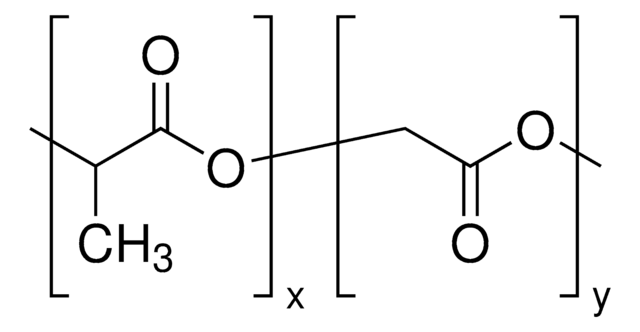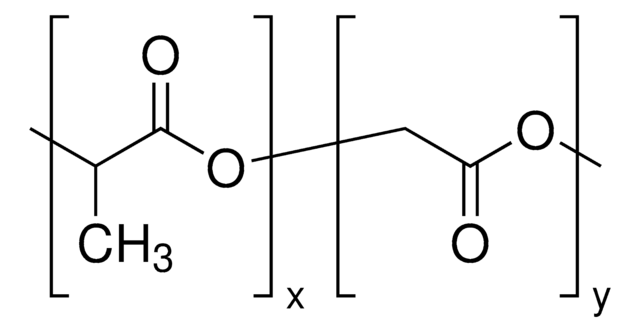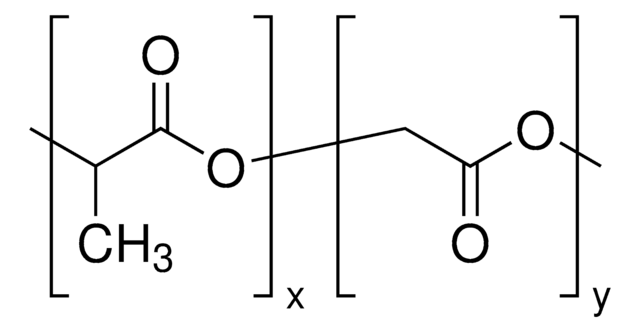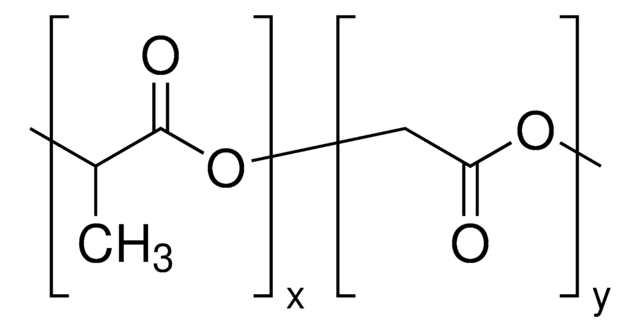739960
Resomer® RG 505, Poly(D,L-lactide-co-glycolide)
ester terminated, Mw 54,000-69,000
Synonym(s):
PLGA
Sign Into View Organizational & Contract Pricing
All Photos(1)
About This Item
Linear Formula:
[C3H4O2]x[C2H2O2]y
CAS Number:
MDL number:
UNSPSC Code:
12162002
NACRES:
NA.23
Recommended Products
Quality Level
form
amorphous
feed ratio
lactide:glycolide 50:50
mol wt
Mw 54,000-69,000
degradation timeframe
<3 months
viscosity
0.61-0.74 dL/g, 0.1 % (w/v) in chloroform(25 °C, Ubbelohde) (size 0c glass capillary viscometer)
transition temp
Tg 48-52 °C
storage temp.
2-8°C
SMILES string
O2C(C(=O)OC(C2=O)C)C.O1CC(=O)OCC1=O
InChI
1S/C6H8O4.C4H4O4/c1-3-5(7)10-4(2)6(8)9-3;5-3-1-7-4(6)2-8-3/h3-4H,1-2H3;1-2H2
InChI key
LCSKNASZPVZHEG-UHFFFAOYSA-N
Related Categories
General description
Poly(lactide-co-glycolide)(PLGA) is a biodegradable polymer used in the preparation of polymericmicrospheres. These polymers degrade in vivo by hydrolysis of their esterbackbone into non-toxic products, which are excreted by the kidneys oreliminated as CO2 and water through biochemical pathways. PLGAmicrospheres have been widely used to encapsulate drug molecules and have beenused as long-acting, sustained-release pharmaceutical formulations.
Application
Poly(lactide-co-glycolide)(PLGA) can be used to fabricate sustained-release drug delivery systems, for example, it can be used to encapsulate the anti-inflammatory lipophilic drug atorvastatin.
Legal Information
Product of Evonik
RESOMER is a registered trademark of Evonik Rohm GmbH
Storage Class Code
11 - Combustible Solids
WGK
WGK 3
Flash Point(F)
Not applicable
Flash Point(C)
Not applicable
Choose from one of the most recent versions:
Already Own This Product?
Find documentation for the products that you have recently purchased in the Document Library.
Customers Also Viewed
Teresa Musumeci et al.
International journal of pharmaceutics, 440(2), 135-140 (2012-10-20)
Melatonin, a neurohormone secreted by the pineal gland, is able to modulate intraocular pressure (IOP). The aim of this study was to generate nanoparticle (NPs) sustained release formulations that allow to extend the pre-corneal residence time of melatonin, thus prolonging
Maria Kirzhner et al.
Ophthalmology, 120(6), 1300-1304 (2013-02-13)
To compare wrapped and polymer-coated hydroxyapatite implants in children undergoing primary enucleation with no adjuvant therapies. Retrospective, interventional cohort study. All children undergoing primary enucleation without adjuvant therapies between 1999 and 2009 at a tertiary pediatric cancer hospital. Review and
Igor Jeroukhimov et al.
Journal of the American College of Surgeons, 218(1), 102-107 (2013-11-12)
Chronic pain after inguinal hernia repair occurs in 16% to 62% of patients. The underlying mechanism probably involves sensory nerve damage and abnormal healing that might be influenced by the materials chosen for the procedure. We hypothesize that nonabsorbable sutures
Aline M Thomas et al.
Biomaterials, 34(9), 2213-2220 (2013-01-08)
Bridges implanted into the injured spinal cord function to stabilize the injury, while also supporting and directing axon growth. The architecture of the bridge is critical to its function, with pores to support cell infiltration that integrates the implant with
Ruchit Trivedi et al.
Nanotechnology, 23(50), 505101-505101 (2012-11-29)
Our purpose was to assess sustained delivery and enhanced efficacy of pirfenidone-loaded nanoparticles after intratracheal instillation.Poly(lactide-co-glycolide) nanoparticles containing pirfenidone (NPs) were prepared and characterized. Biodistribution of NPs and solution was assessed using LC-MS after intratracheal administration in C57Bl/6 mice at
Our team of scientists has experience in all areas of research including Life Science, Material Science, Chemical Synthesis, Chromatography, Analytical and many others.
Contact Technical Service








